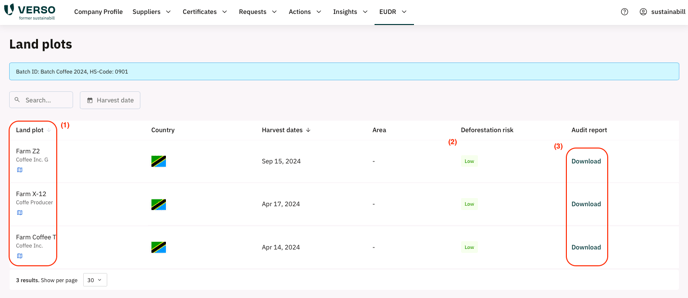Risk assessment for Importers
Due Diligence - Inbound (Geodata)
TABLE OF CONTENTS
To get to your "Supplier geodata" Insights,
1. Go to "EUDR" in the main menu.
2. Click "Due Diligence".
3. Select "Supplier geodata".

I. General Information
The EUDR due diligence dashboard for incoming data (geodata) is intended for companies that have to comply with the European Deforestation Regulation (EUDR) as an importer.
It provides you with the results of the risk analysis of the landplot (geodata) provided by your suppliers for the product batches requested. It also enables you to verify the identified risks.
II. Structure of the Supplier Geodata Dashboard
The EUDR supplier geodata dashboard is divided into 2 areas:
1. KPI's
This area is to derive aggregated analyses for all relevant batches listed below. The left part, "Batch verification", shows the final result of the risk analysis for all relevant batches: whether they are compliant, non-compliant, or still to be reviewed. Whether a batch is compliant or non-compliant is determined by you based on the risk analysis. Below, it is described how to proceed in the risk analysis and how to determine the result of the verification.
The right part, "Risk categories", shows a distribution of the overall risks of your sourced batches per EUDR risk category.

2. Batch list
The second section is used for detailed evaluation of the risk analysis for each batch.

III. Batch list structure and filter options
The batch list is divided into 10 columns with the following attributes per batch, which can be customized individually and easily using search and filter options.
List structure
- Batch ID
- HS code
- Supplier
- Country of origin
- EU benchmarking
- Supply chain risk
- Deforestation risk
- Legislation risk
- Verification
- Updated
Filter options
There are multiple options to filter the list view.

Viewing landplots
The platform offers the option of viewing the plots of land behind each batch. To do this, select the map icon below the batch to open a pop-up from the map tool.

Here you have the option to switch on the top right corner between satellite mode and light mode. In the light mode you can make use of the integrated EU forest layer map to see the forest cover for end of 2020, the forest types for end of 2020 (in case of wood).


Please note that the platform uses high-resolution satellite data for analyzing deforestation/degradation, which is even more accurate than the EU forest maps, in order to avoid false positives. The risk is calculated automatically.
The platform offers the option of displaying the land plots behind each batch in a list view, with the deforestation risk status for each land plot and an integrated audit report. To do this, select the list icon below the batch to open a new window.

Here you have the option to see all land plots behind this batch (1) with the according risk status (2) and to download the audit report for the deforestation risk (3).

Viewing orders
The platform offers the option of viewing the orders behind each batch. To do this, go to Due Diligence Dashboard > Inbound (Geodata) and select the package icon below the batch to open a new window.

Here you have the option to see all orders (1) behind this batch and the according inbound products (2).

IV. Logic of the risk analysis
The risk analysis of the batches is based on the EU benchmarking, which classifies the countries of origin into one of the following risk categories: High, Standard, and Low risk.
If the country of origin for a batch is assessed as low risk under the EU benchmarking, Article 13 of the EUDR applies. This means your company is only subject to a simplified due diligence obligation.
In the platform, this is shown as the EU Benchmarking Risk. When this risk is low, you still need to check the complexity of the batch’s supply chain and assess whether there is a risk of mixing with batches of unknown origin or from countries or regions classified as standard or high risk (risk of circumvention). In the platform, this is reflected as the Supply Chain Risk

By clicking on the Supply Chain Risk result, you can see the two underlying categories:
- Risk of circumvention
-
Complexity of the supply chain

If the country of origin for a batch is rated as standard or high risk under the EU benchmarking, or if risks are identified in the supply chain, then additional checks are required. These include assessing both the deforestation risks of the registered land plots and the legality risks in the country of origin.
For the deforestation and degradation analysis, the platform uses high-resolution satellite data.
The results of this analysis are shown under Deforestation Risks (1). This score is based on the highest risk level among all land plots linked to the batch (you can view all land plots individually in the platform, see "viewing landplots"). As proof, the platform automatically generates an audit document for each land plot.

For the legality analysis, the platform uses expertly verified indices. The overall Legality Risk result (2) is calculated as the median of all relevant subcategories.
By clicking on the Legality Risk result, you can view the detailed breakdown across all seven subcategories.

For more details on the methodology and the data sources used in the risk analysis, click the link “How are risks calculated”.
In the last column of the batch list "Verification", each batch must be marked as either compliant or non-compliant, based on the platform’s automated risk analysis.
Our recommendations:
-
Low risk results → Set the verification to compliant.
-
Medium risk results → Set the verification to compliant, but only after confirming that the risk is negligible (for example, through certifications).
-
High risk results → First implement appropriate measures, then set the verification to non-compliant

![VERSO_Logo-1.png]](https://helpdesk.verso.de/hs-fs/hubfs/Globale%20Design-Elemente/VERSO_Logo-1.png?height=50&name=VERSO_Logo-1.png)
